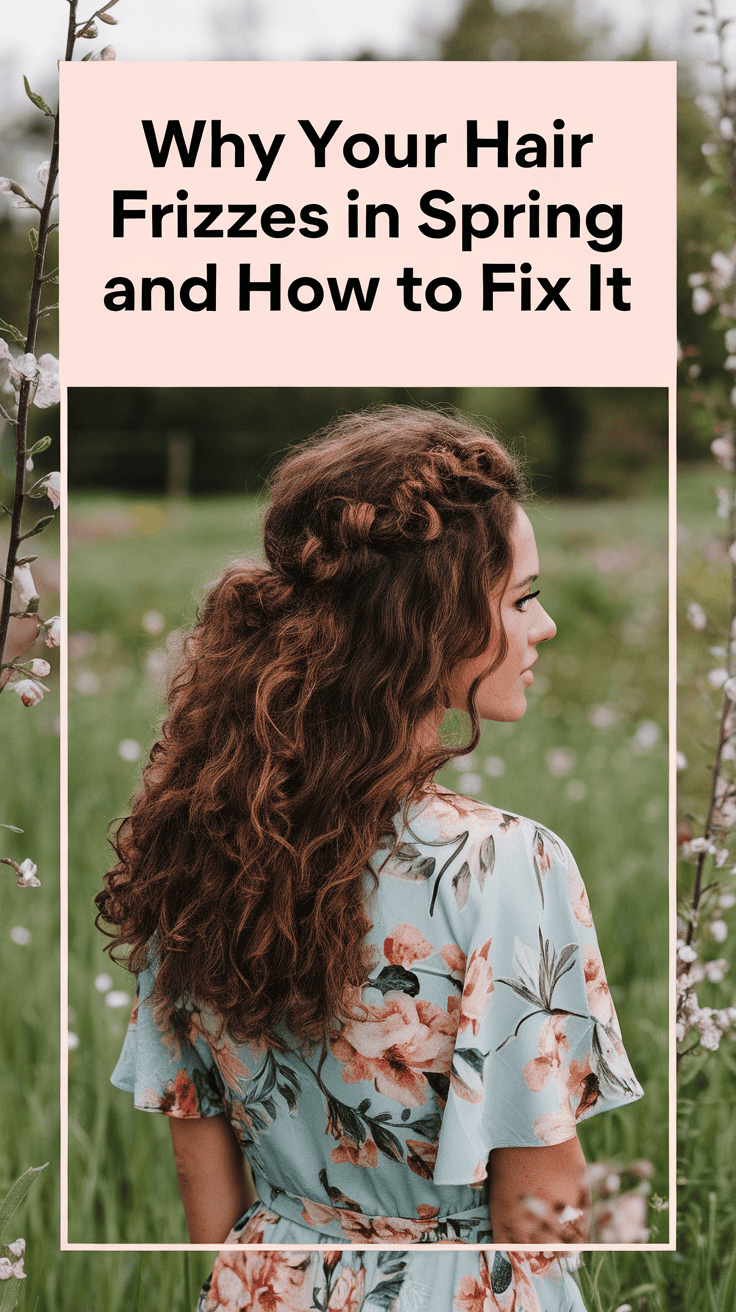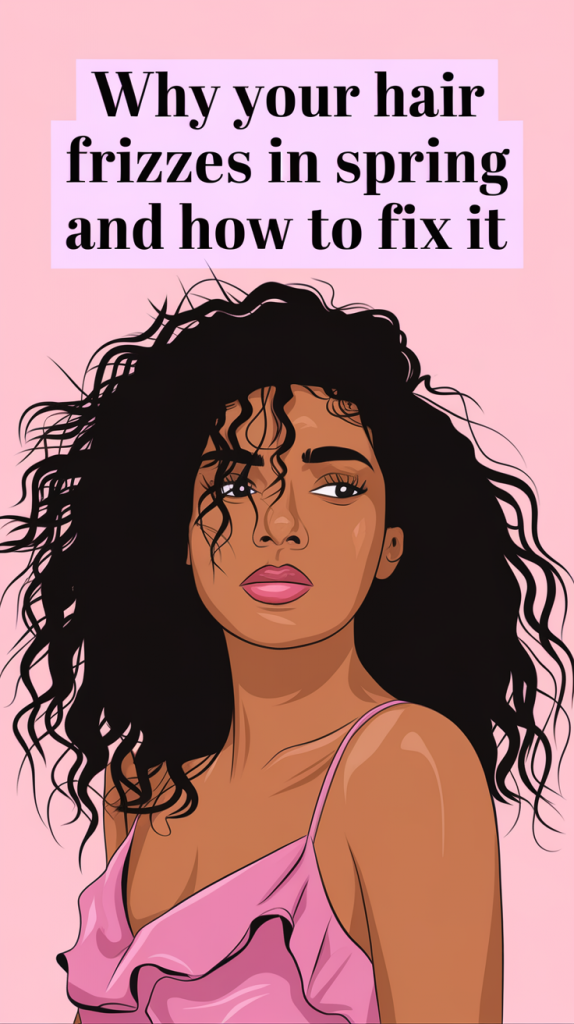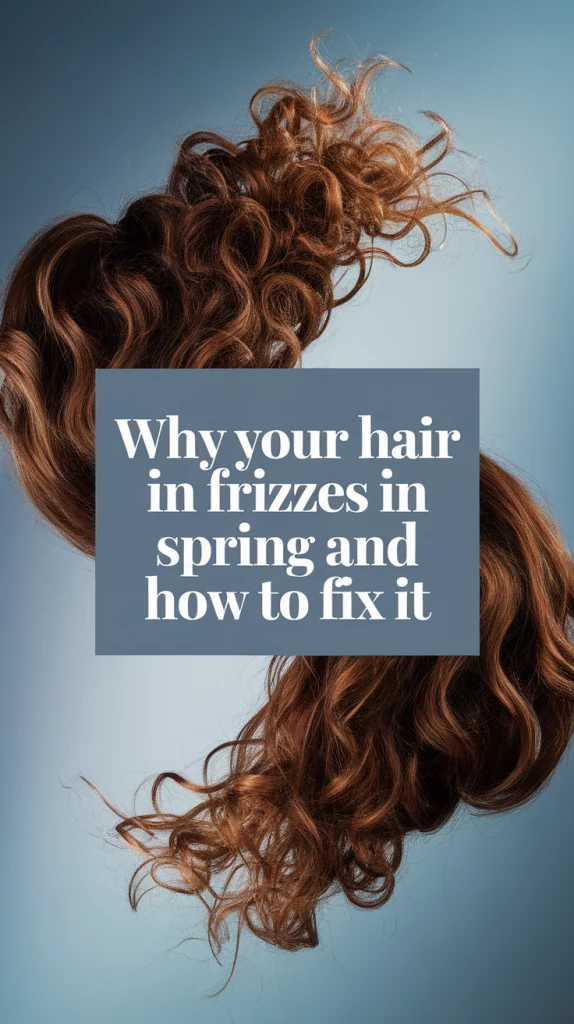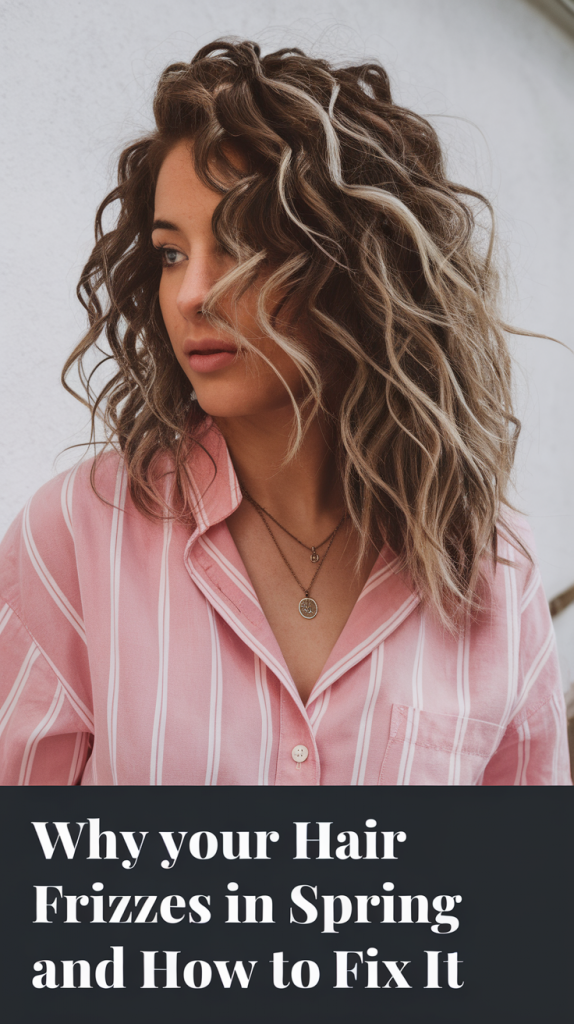Why Your Hair Frizzes in Spring and How to Fix It in 2025

Spring is in the air… and so is the frizz. You’ve carefully styled your hair, stepped outside to enjoy the warmer breeze — and suddenly, your sleek look turns into a fluffy halo. Sound familiar?
Frizzy hair in spring 2025 isn’t just an inconvenience — it’s a seasonal struggle that affects millions of women across the US. But don’t worry: you’re not alone, and there is a solution. In this guide, I’ll walk you through why frizz happens in spring, which hair types are most vulnerable, and how to build a haircare routine that actually works with the weather, not against it.
Whether you’re rocking natural curls, straightened strands, or a fresh balayage, if your hair reacts to the spring air like it’s been electrocuted, this article is for you.

Why Does Hair Frizz in the Spring?
Here’s what’s really going on behind the springtime frizz — and how small missteps can make it ten times worse.
Spring Weather = Humidity + Temperature Swings
Spring brings renewal — blooming flowers, fresh air, and unfortunately… moisture. Frizz is your hair’s reaction to humidity. When the air becomes moist, hair absorbs the extra water like a sponge. For damaged or porous hair, this means the hair shaft swells and the outer layer (cuticle) lifts — hello, frizz.
Did you know that humidity levels in most parts of the US spike by 20–30% from winter to spring? That sudden jump wreaks havoc on the structure of your hair.
Scalp Transition and Seasonal Dryness
Your scalp is smart — it adjusts to seasonal shifts. In winter, it tends to produce less oil. But come spring, oil glands wake up, and that’s when things can get messy. Your roots may feel greasier, while your ends stay dry and brittle. This imbalance only amplifies the frizz effect.
Common Mistakes That Make It Worse
Many people unknowingly make things worse during spring:
-
Using sulfate-laden shampoos that strip away natural oils
-
Roughly towel-drying hair
-
Skipping leave-in hydration
-
Brushing dry curls or waves (don’t do it!)
Which Hair Types Are Most Prone to Frizz?
Here’s a closer look at which hair types tend to frizz more easily—and the science behind it.

The Porosity Factor
Hair porosity — or your hair’s ability to absorb and retain moisture — plays a key role in how frizzy you get.
Low porosity: Hair repels moisture and products sit on top
High porosity: Hair absorbs moisture easily, often too much
Medium porosity: The happy medium, but still vulnerable to seasonal changes
Not sure where you fall? Try the water test: place a clean strand in a glass of water. If it sinks, it’s porous. If it floats, it’s low porosity.
Frizz-Prone Hair Types (and Why)
| Hair Type | Frizz Risk | Why It Happens |
|---|---|---|
| Curly & Coily | Very High | Naturally porous, absorbs moisture fast |
| Wavy | High | Cuticle is lifted, reacts to air |
| Straight but bleached | Medium to High | Damaged cuticle = frizz magnet |
| Fine, oily roots | Medium | Oil + moisture clash |
If your hair is chemically treated or highlighted, it’s even more susceptible. The spring air sneaks into damaged cuticles, making strands balloon and expand.
How to Fix Spring Frizz — Step by Step
Spring is all about balance—so let’s break down exactly how to keep frizz in check from root to tip.
1. Update Your Haircare Routine for Spring
Lightweight hydration is your new best friend. That means:
Sulfate-free shampoos
Creamy, hydrating masks (2x/week)
Leave-in conditioners that offer frizz control
Natural oils like argan, jojoba, or marula to seal in moisture
Avoid heavy butters unless you have ultra-coarse hair. Spring hair thrives on breathable moisture, not weight.
2. Don’t Skip Scalp Care
Healthy scalp = healthier hair.
Use gentle exfoliating scrubs once a week and balance your pH with apple cider vinegar rinses. Hydrating scalp mists can help regulate oil production and soothe any itchiness caused by pollen or temperature swings.
Have you ever noticed your hair looks frizzier near the scalp? That’s often a sign your skin up there needs TLC.
Must-Have Products for Spring Frizz in 2025
Here’s a cheat sheet of top product categories to battle spring frizz this year:
| Product Type | What It Does | Pro Tip |
|---|---|---|
| Anti-frizz spray | Locks out moisture, smooths cuticle | Apply on damp hair before drying |
| Curl cream | Defines shape, adds moisture | Use a dime-size amount per section |
| Silk serum or oil | Seals in hydration, boosts shine | Avoid roots if prone to oiliness |
| Microfiber towel or wrap | Reduces friction, prevents frizz while drying | Never rub — just scrunch gently |
| Wide-tooth comb | Detangles without damage | Use in shower with conditioner |
Pro Tips and Home Remedies That Actually Work
Ready to give your hair some extra love without leaving the house? These DIY remedies and pro-approved tricks are total game-changers.
DIY Avocado Mask
-
½ ripe avocado
-
1 tablespoon coconut oil
-
1 teaspoon honey
Mash and apply from mid-lengths to ends. Leave on for 20 minutes, rinse thoroughly.
Why it works: Fatty acids + natural oils = smooth, nourished strands.

Apple Cider Vinegar Rinse
-
2 tablespoons ACV
-
1 cup cool water
Pour over hair after shampooing. Let sit for 2 minutes, then rinse. This helps close the cuticle and restore shine.
Use the “Pineapple Method” at Night
Tying curls into a loose bun on top of your head with a silk scrunchie prevents overnight friction and frizz.
2025 Trends: New Anti-Frizz Innovations Worth Trying
This year, haircare brands are getting smarter — and more targeted. Here’s what’s trending:
-
Bond-building leave-ins that repair frizz from within
-
Humidity-resistant mists with hydrolyzed proteins
-
Thermal brushes with ionic tech that reduce static
-
Silk pillowcases 2.0 — now with botanical infusions
These high-tech helpers are designed for the unpredictable spring weather of 2025 — think Miami-level humidity with Chicago-style wind.
Daily Habits That Keep Frizz Away
Frizz isn’t just about what products you use — it’s about how you treat your hair every day.
Here are smart habits to adopt this spring:
-
Never leave the house with wet hair — it’ll soak up moisture
-
Use a satin or silk pillowcase
-
Don’t over-brush or over-style
-
Always apply a heat protectant (even on cloudy days)
Final Thoughts: What You Need to Remember
Spring 2025 is a beautiful season, but it comes with a frizzy side effect — especially for textured or damaged hair.
Key Takeaways:
-
Frizz happens when moisture enters your hair shaft and disrupts its structure.
-
Certain hair types — curly, wavy, bleached — are more prone to frizz.
-
A spring-friendly routine includes lightweight hydration, scalp care, and styling products that lock in moisture.
-
Don’t skip silk pillowcases, anti-frizz sprays, or DIY masks.
-
High-tech products in 2025 make frizz-fighting easier than ever before.
💬 So, what’s your go-to trick for taming spring frizz? Have a favorite product or hack? Drop it in the comments — let’s swap secrets!





